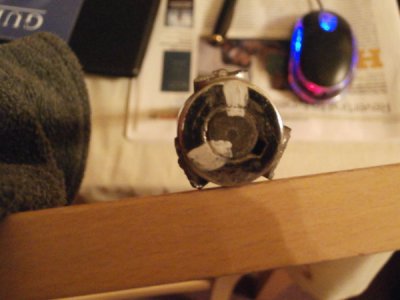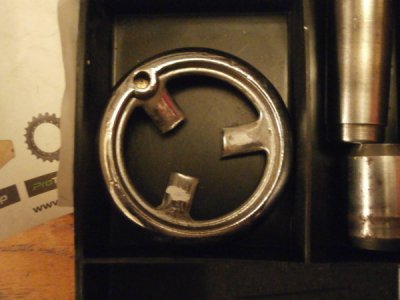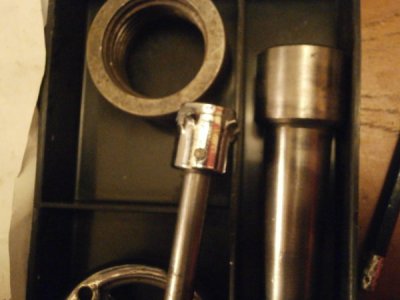-
Welcome back Guest! Did you know you can mentor other members here at H-M? If not, please check out our Relaunch of Hobby Machinist Mentoring Program!
You are using an out of date browser. It may not display this or other websites correctly.
You should upgrade or use an alternative browser.
You should upgrade or use an alternative browser.
School me on collets for the Atlas lathe, 3c, 3at,or both?
- Thread starter Uncle Buck
- Start date
- Joined
- Dec 25, 2011
- Messages
- 10,552
Yep, that is funny. One comment to add - Atlas spindles are all countersunk on the left end. Hence the 45 deg. taper on all of the thrust bearings. Looking at one of the photos of your lathe, it appears that your spindle isn't countersunk. So you were quite right to leave the end of the thrust bearing straight.
As the subject of drawbars and MT collets came up, I'll add that most of the drawbar thrust washers I've seen (including an original from Atlas) have also been beveled. However, back when I started adding various collet types to my 3996, the first drawbar I found was aftermarket. The person who made it made the thrust bearing about the same length and about the same OD as the factory one I later acquired. But instead of beveling one or both ends, he cut a 3/4" dia. step about 3/16" long on one end. I find that this design is actually more comfortable to use with a drawbar than the beveled ones. On a lathe (at least on an Atlas 10" or 12", the drawbar is much smaller in diameter than the hole through the spindle. When you loosen the drawbar to remove the collet, cutter or workpiece, the weight of the handle, thrust bearing and drawbar causes the tapered thrust bearing to follow the handwheel to the left and drop out of the bevel in the spindle unless you hold it up in the bevel with one hand. You almost always have to bang on the handwheel with something to loosen the collet. And when you do, if the bearing isn't still up and concentric with the spindle hole, you tend to bang the bearing against the end of the spindle and aren't pushing on the collet axis. With the stepped bearing, everything stays in alignment and it just feels better.
As the subject of drawbars and MT collets came up, I'll add that most of the drawbar thrust washers I've seen (including an original from Atlas) have also been beveled. However, back when I started adding various collet types to my 3996, the first drawbar I found was aftermarket. The person who made it made the thrust bearing about the same length and about the same OD as the factory one I later acquired. But instead of beveling one or both ends, he cut a 3/4" dia. step about 3/16" long on one end. I find that this design is actually more comfortable to use with a drawbar than the beveled ones. On a lathe (at least on an Atlas 10" or 12", the drawbar is much smaller in diameter than the hole through the spindle. When you loosen the drawbar to remove the collet, cutter or workpiece, the weight of the handle, thrust bearing and drawbar causes the tapered thrust bearing to follow the handwheel to the left and drop out of the bevel in the spindle unless you hold it up in the bevel with one hand. You almost always have to bang on the handwheel with something to loosen the collet. And when you do, if the bearing isn't still up and concentric with the spindle hole, you tend to bang the bearing against the end of the spindle and aren't pushing on the collet axis. With the stepped bearing, everything stays in alignment and it just feels better.
Robert, that's hilarious! I made the very part you describe, with those exact details, before your post. It works like a charm. All the collets, not just the long Precision ones. You're right, there was something missing. Thanks for the help!
Forgive the thread resurrection but I'm hugely confused about setting up milling cutters in my 10F Atlas (TV36).
I have attached pictures of the items that came with my lathe which appear to be those mentioned at p168 "Manual of Lathe Operation" (described as a "drawbar, sleeve and an arbor for straight shank cutters").
My first query is that my drawbar is solid with an external thread but everyone else seems to have a hollow tubular drawbar with an internal thread (even the one in the manual on close inspection). Does this mean I am missing a drawbar?
With the solid drawbar & arbor, do I need cutters that have an indent on the shank (so that the grubscrew fits into the notch) or is the friction of the grubscrew simply enough to hold a smooth shank cutting head?
Does the "sleeve" act as a spacer? And if so, does it go at the rear or the front (chuck side) of the headstock spindle?
Am I correct in thinking that my arbor will not hold 3AT or 3C collets?
Even as I'm writing this it strikes me that I might be confusing myself about the use of collets - I understand that they provide superior "gripping power" over chucks (especially with smaller diameters) but do I need them to mill on my lathe?
Sorry for so may questions - I'm sure there will be many more
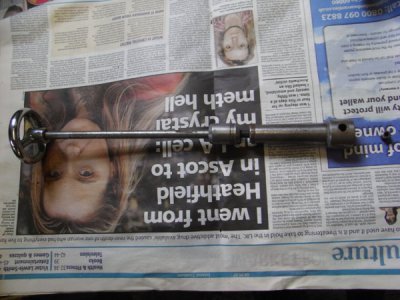
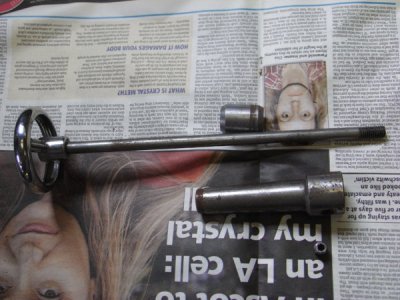
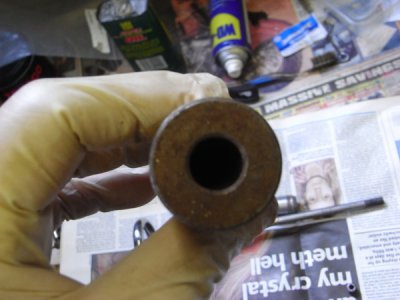
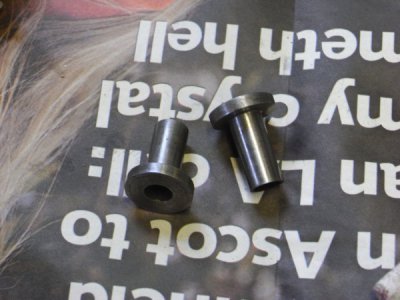
I have attached pictures of the items that came with my lathe which appear to be those mentioned at p168 "Manual of Lathe Operation" (described as a "drawbar, sleeve and an arbor for straight shank cutters").
My first query is that my drawbar is solid with an external thread but everyone else seems to have a hollow tubular drawbar with an internal thread (even the one in the manual on close inspection). Does this mean I am missing a drawbar?
With the solid drawbar & arbor, do I need cutters that have an indent on the shank (so that the grubscrew fits into the notch) or is the friction of the grubscrew simply enough to hold a smooth shank cutting head?
Does the "sleeve" act as a spacer? And if so, does it go at the rear or the front (chuck side) of the headstock spindle?
Am I correct in thinking that my arbor will not hold 3AT or 3C collets?
Even as I'm writing this it strikes me that I might be confusing myself about the use of collets - I understand that they provide superior "gripping power" over chucks (especially with smaller diameters) but do I need them to mill on my lathe?
Sorry for so may questions - I'm sure there will be many more





- Joined
- Dec 25, 2011
- Messages
- 10,552
Robin,
Machinists, expecially new hobbiest ones, have a tendency to be sloppy about nomenclature. In fact, hobbiests in general are bad about this. Generically, there are two types of threaded devices that work by sticking them through the hollow spindle from the left end. They are called draw bars and draw tubes. Draw bars are (almost always) solid, and have male threads. Draw tubes are hollow and have female threads.
The most common draw bar in the English speaking world is 3/8" in diameter and has 3/8"-16 threads. There is no "standard" draw tube. They are identified by the collet type that they fit, most of which are of different outside diameters with different pitch threads.
What you probably have is the Atlas cutter holder set for 3MT (or MT3). It consists of a 3.8"-16 draw bar. a 3MT to 1/2" diameter cutter holder with set screw, and four reducing bushings. And I will throw in here that you never ever want to use a Weldon style (with the set screw flat ground on the side of the shank) cutter other than one with a 1/2" dia. shank that does not require a bushing. Those are safe to use. But if you put a smaller shank diameter one into the appropriate reducing bushing and tighten the set screw onto the flat in the bushing with the flat on the cutter right under the set screw, you will probably never manage to remove the cutter and bushing from the 3MT cutter holder.
Anyway, this setup is used only for holding milling cutters whose shanks fit the holder or one of the bushings. It could be use to hold a short work piece of the proper diameter, but the set screw will mar the surface. So you do not want to try to use it for that.
The draw bar is made for tightening tools that have a taper that matches the taper in the lathe or milling machine spindle. The only collets that it will tighten (close) on your machine are 3MT collets, which only come in 1/16" diameter increments. You can use 3MT collets for holding short work pieces but the work piece diameter must be withing about +/- 0.007" of the collet diameter.
If you want to do mill work with the Atlas milling attachment mounted in place of the compound, it sounds as though you have what you need so long as your cutter shank diameters are 1/4", 5/16", 3/8", 7/16" or 1/2". But if you want to use collets for holding work to turn, face or thread on the lathe, aside from short work pieces in the range 1/16" to 3/4" by 16ths that 3MT collects come in, you need something else.
The three collet types that are commonly used on an Atlas 10" or 12" are 3AT (which is what Atlas/Clausing used to sell), 3C, and any of the European type ER collets. The first two require a matching draw tube and a 3MT to 3AT or 3MT to 3C closer adapter. The ER collets require what's usually called a collet chuck, of which there are two types, those that screw onto the spindle threads (and allow the work piece to extend back through the spindle) and those built onto a 3MT arbor secured by a draw bar (that don't).
The pro's and con's of these three types of collets is another subject (which I think this thread was originally about).
Machinists, expecially new hobbiest ones, have a tendency to be sloppy about nomenclature. In fact, hobbiests in general are bad about this. Generically, there are two types of threaded devices that work by sticking them through the hollow spindle from the left end. They are called draw bars and draw tubes. Draw bars are (almost always) solid, and have male threads. Draw tubes are hollow and have female threads.
The most common draw bar in the English speaking world is 3/8" in diameter and has 3/8"-16 threads. There is no "standard" draw tube. They are identified by the collet type that they fit, most of which are of different outside diameters with different pitch threads.
What you probably have is the Atlas cutter holder set for 3MT (or MT3). It consists of a 3.8"-16 draw bar. a 3MT to 1/2" diameter cutter holder with set screw, and four reducing bushings. And I will throw in here that you never ever want to use a Weldon style (with the set screw flat ground on the side of the shank) cutter other than one with a 1/2" dia. shank that does not require a bushing. Those are safe to use. But if you put a smaller shank diameter one into the appropriate reducing bushing and tighten the set screw onto the flat in the bushing with the flat on the cutter right under the set screw, you will probably never manage to remove the cutter and bushing from the 3MT cutter holder.
Anyway, this setup is used only for holding milling cutters whose shanks fit the holder or one of the bushings. It could be use to hold a short work piece of the proper diameter, but the set screw will mar the surface. So you do not want to try to use it for that.
The draw bar is made for tightening tools that have a taper that matches the taper in the lathe or milling machine spindle. The only collets that it will tighten (close) on your machine are 3MT collets, which only come in 1/16" diameter increments. You can use 3MT collets for holding short work pieces but the work piece diameter must be withing about +/- 0.007" of the collet diameter.
If you want to do mill work with the Atlas milling attachment mounted in place of the compound, it sounds as though you have what you need so long as your cutter shank diameters are 1/4", 5/16", 3/8", 7/16" or 1/2". But if you want to use collets for holding work to turn, face or thread on the lathe, aside from short work pieces in the range 1/16" to 3/4" by 16ths that 3MT collects come in, you need something else.
The three collet types that are commonly used on an Atlas 10" or 12" are 3AT (which is what Atlas/Clausing used to sell), 3C, and any of the European type ER collets. The first two require a matching draw tube and a 3MT to 3AT or 3MT to 3C closer adapter. The ER collets require what's usually called a collet chuck, of which there are two types, those that screw onto the spindle threads (and allow the work piece to extend back through the spindle) and those built onto a 3MT arbor secured by a draw bar (that don't).
The pro's and con's of these three types of collets is another subject (which I think this thread was originally about).
Thanks for the replies.
Terry - my drawbar has a 3/8" UNC thread (16 TPI)
Robert - thanks, that's cleared up some issues for me.
The ER collets are much more readily available over here (UK) although there is a used set of 3AT collets currently on US Ebay in Massachusetts.
I have provisionally tried out my set up on the lathe today and it seems to lock the cutter holder in the headstock (and a 1/2" cutter is surprisingly tight in the holder (I just assumed it would spin).
Terry - my drawbar has a 3/8" UNC thread (16 TPI)
Robert - thanks, that's cleared up some issues for me.
The ER collets are much more readily available over here (UK) although there is a used set of 3AT collets currently on US Ebay in Massachusetts.
I have provisionally tried out my set up on the lathe today and it seems to lock the cutter holder in the headstock (and a 1/2" cutter is surprisingly tight in the holder (I just assumed it would spin).
- Joined
- Dec 25, 2011
- Messages
- 10,552
Robin,
The handwheel is pinned to the stud with probably a grooved taper pin. I can see one end of it in your third photo. Determine which is the smaller end and drift it out with a pin punch. The handwheel is the same as I think the one on the milling attachment, except without the handle and probably not keyed (I never noticed on mine).
The handwheel is pinned to the stud with probably a grooved taper pin. I can see one end of it in your third photo. Determine which is the smaller end and drift it out with a pin punch. The handwheel is the same as I think the one on the milling attachment, except without the handle and probably not keyed (I never noticed on mine).
- Joined
- Dec 25, 2011
- Messages
- 10,552
Thanks for the replies.
Terry - my drawbar has a 3/8" UNC thread (16 TPI)
Robert - thanks, that's cleared up some issues for me.
The ER collets are much more readily available over here (UK) although there is a used set of 3AT collets currently on US Ebay in Massachusetts.
I have provisionally tried out my set up on the lathe today and it seems to lock the cutter holder in the headstock (and a 1/2" cutter is surprisingly tight in the holder (I just assumed it would spin).
Robin,
Milling and cutter shanks are finish ground to tight tolerances, as is the hole in the cutter holder. So they are a snug fit. Otherwise, the set screw would tighten them off center and the hole that they would cut would be oversized.
I think that the ER collets would be your better bet. Certainly cheaper. And if the size family that you choose is the ER32, can handle parts up to 3/4" diameter through the spindle (if you get the screw-on chuck). If you do opt for the 3AT or 3C collets, they go from 1/64" to 1/2" because the draw tube must slide through the 25/32" spindle bore. And although I have both for reasons I won't get into, you don't need both. The draw tube effective length is different for the two types because the collet lengths are different.

